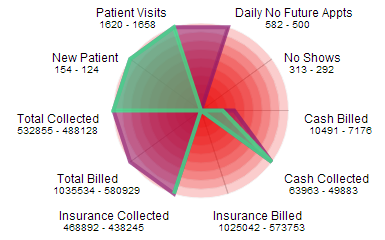Revenue | Automating Billing Reports

Where Should We Go Tonight? Can Dr. Ben make the commitment to automate his billing reports and take control of his office finances? Ben and Carmen were having a familiar conversation: what should we do about dinner? They had both returned home from busy days at work, both were a little frazzled and hungry and – as usual – the refrigerator was lacking in appetizing options. “I’ve heard that the new Indian buffet is very good,” said Carmen. “But it’s downtown and it’s almost 6:30, so there might be a bit of a wait.” Ben thought about that. “That sounds delicious and we should definitely get there at some point, but I’m too hungry for a long wait. Why don’t we just go grab some Chinese at our usual place – there’s never a wait there.” “You know, Ben, we’re never thrilled with our meals there and we’ve tried everything on the menu,” Carmen said. “There’s a pretty good reason why there’s never a wait there.” They looked at each other testily for a moment – hunger and a lack of accord might become a threat to their nice evening out. Just then Jonathan came running out of the living room and hugged Ben, happy to see his father. “Daddy, you’ve got to see my new art book – I drew all of the pictures myself!” “Of course, Jonathan, I’d love to see it,” Ben said. “Listen, Carmen, I’m going to look at Jonathan’s artwork and then we can go try that new restaurant downtown. It sounds like fun.” He went into the living room with Jonathan and sat down on the couch with him. He wondered why he was so irritable this evening as he turned the pages of the book. Ben’s thoughts kept returning to earlier in the week, when Luisa explained the difficulty she was having keeping track of the office finances. Too often they were surprised to learn that some patients had accounts that were past due. And between varying accounts receivable windows and some insurance companies that were dragging out the reimbursement process due to even minor errors in data entry, it was making confident budgeting impossible. Ben pondered how difficult it was for him to keep track of crucial patient information until he put a system in place. Between his voice recorder, written notes and meticulously organized files on his computer, he felt confident in his mastery of the most important details for each patient. But then he thought about how many areas of office management that Luisa was expected to stay abreast of: office supplies, scheduling, working with outside vendors, insurance reimbursements… her plate was truly full, even with Pam’s able assistance. And considering that third parties don’t always respond when and how you want them to, the level of complexity and the time it takes to handle each task can be multiplied exponentially. Carmen – who had a business degree and always seemed to be several steps ahead of Ben in understanding the ins and outs of finance – and he had talked about the program that could automate many of the functions of his office and Ben had been serious about actually following through and implementing it. But there always seemed to be a crisis to attend to… trying to collect from patients who owe balances beyond a certain date, trying to figure out where long-overdue insurance reimbursements were. Ben knew when he started his practice that it wouldn’t only be about attending to patients – he knew there would be crucial administrative work that would have to be handled by his staff. Luisa had certainly had shown she understood the benefits of having data to inform business decisions. But customization is key when reviewing large amounts of detailed data and it didn’t seem like Luisa was tapping the full potential of the system when it came to the billing reports. Ben knew that there were reports that could be broken down in a number of different ways and could be endlessly customized so that they could stay on top of potential problems. Well, maybe we should take some time to figure it out together, Ben thought. Without getting these reports done – and done right – we really have no idea how well our office is functioning. This sounds like something we should talk about on Monday. But first he wanted to enjoy a nice dinner with Carmen and Jonathan. He appreciated how Carmen listening to him talk about the various issues in his office, and she often responded with some great feedback. That business degree had served both of them well over the years. When Ben had finished looking at Jonathan’s artwork and congratulating him on being the next Rembrandt, he found Carmen in the hallway, ready to go – her purse in one hand and a small lunchbox in the other. “What’s in the lunchbox, Carmen?” Ben asked. “Well, since you’ve agreed to my pick of restaurants, I wanted to reciprocate by packing some snacks for the drive so you won’t be starving while we wait for a table,” Carmen said with a smile. “I’ve got some fruit, cheese and crackers, and your favorite – cashews.” Ben took Jonathan’s hand and smiled at Carmen, who never failed to make even the most hectic and frustrating day better. “We’d better get going,” he said. “Maybe we can be on the lookout for a new Chinese place on our way there.” Both were laughing on their way out the door. Can Dr. Ben make the commitment to automate his billing reports and take control of his office finances? Disclaimer: For HIPAA compliance, all characters appearing in this post are fictitious. Any resemblance to actual persons or actual events is purely coincidental.
Visual Embedded Analytics in Your Software

Can of Worms What do the numbers mean to you and your practice? Opening your own practice means opening a whole new can of worms. That’s because there are so many elements that they don’t teach you about in school: aspects of running a business that you’re left to learn on the fly — all while attempting to provide quality care for your patients. One of the most critical components of achieving practice success is making sense of the numbers. There are numbers everywhere, from revenue to no-shows, from patient visits to accounts receivable. When you first start to look at them, it can almost seem like you’re staring at signs in a foreign language, hoping that the context might shed some light on what they mean. Practice management software can help, but until you know what numbers are most important to your practice — and how they signify growth or, conversely, difficulties — you’re still left wading through a mess of mathematical gobbledygook. Fortunately, there are analytics — tools to help you make sense of the data — available, and the best chiropractic software solutions, such as Genesis, embed those tools into the program so that they’re easily and immediately accessible. Offering a visual presentation of the numbers, these analytics finally make it possible for you to interpret and understand the numbers that drive your practice. Examples include: Radar chart — Visually resembling a spiderweb, the radar chart shows multiple variables on axes starting from the same point, radiating outward like spokes on a wheel. The length of the spoke is proportional to the magnitude of the data. This allows you to examine the correlation of values — say, accounts receivable and NFAs — that aren’t otherwise measured in comparable units. Trend report — A trend report presents data on a traditional line graph, thereby allowing you to see the peaks and valleys of your information — and the inter-relation of different data sets — over time. Histogram — With a histogram, you can choose three charts to show you a graphical representation of a single area of your practice over a given time period (weekly/monthly), depending on the selection. This allows you to gauge how your practice is doing comparatively for a set amount of time. Dashboard — A dashboard is an organized presentation of the numbers, so you can get an at-a-glance picture of where your practice stands on collections and outstanding work. Genesis, for example, can show you failed claims, AR > 120 and outstanding tasks — or “tickets” — on a single screen through its homescreen dashboard. Billing Stats Report — This type of report allows you to view claims by date of service. The report can then be broken down in a number of different ways, depending on what you’re looking for (customizable by practice). The Billing Stats Report, or BSR, is very useful for digging into problems. Ultimately, it’s up to you to determine which numbers provide the best snapshot of practice success; however, analytics are the tools that help bring that snapshot into focus.
Focus, Identify, Create Value and Repeat

Your recipe for working with people you enjoy, know you can help, and making more money. by Garrett B. Gunderson To be as productive as possible it is essential to be crystal clear about what your business is specifically designed to do, and who you are ideally positioned to serve. This means identifying your best existing patients and figuring out who they really are as people. If you can understand what age group, gender, education level, what they do for hobbies, what books they read, where they hang out, how much money they make, etc. then you can make it a point to go out and find more people who are just like your best patients/customers. To do this make a conscious choice to determine who is already existing and “Ideal”, and build a relationship with them. Have appreciation dinners, invite them out to hike or snowshoe, or share experiences with them. Let them become more than just clients or patients – build a relationship. In this process you will not only learn how to serve them better, you’ll understand how to attract more people just like them. This leads to a business full of people that you love to see and who love to come see you. Once this happens the profits are an inevitable result of serving those that appreciate your value the most. They key is to overcome the concern that is you focus or get to narrow that you will miss out on others you could have otherwise have worked with. Here are some questions and considerations to help address and overcome this objection. If you were to look at your top 20 percent of people you work with what percentage of your revenue are they responsible for? How many people have they referred versus the bottom 20 percent? What percentage of your time is used for addressing people that do not pay on time, do not refer people and do not appreciate your service? What impact does that have on your energy, confidence and ultimately the bottom-line? Do you think there are plenty of people in your community or even your state that fit the “ideal” profile? What would your life look like if that was who you spent your time and focus on? What level of value could you create for them? How would it allow you to focus more on value creation and less on appeasing people that do not appreciate who you are, what you do or that simply are not compliant with implementing your recommendations and getting the full value you offer? So, find the best people that you enjoy working with the most. That gets the best results and refer the most people. Focus on building those relationships, cultivating those relationships, and asking them how you can create the most value for them. To discover other overlooked opportunities most business owners miss and to gain more freedom in your business as we expose models most didn’t think was possible, yet are achievable in a short period of time, check out www.freedomfasttrack.com/cfw as I interview business strategist Brandon Allen. Brandon opened up and built Wells Fargo branches for a decade before becoming the COO of my firm, Freedom FastTrack. In order to more fully express his expertise and purpose he now shares his insights and discoveries through business expansion and management with Freedom FastTrack members. In a bottom-line, no fluff interview he will be sharing how to: integrate metrics and numbers to improve business unveil the biggest mistakes business owners make in managing their business (he exposed this for me and transformed my INC 500 business) how can you create and leverage your authority in your market how to address and confront employee behavior in the business time management the key habits to run a successful business and more
Your Data and Practice Management Metrics

Big Data? Can Dr. Ben get the benefits of data-informed decision making in his Practice Management? Carmen stomped around the kitchen, slamming cabinet doors, and mixing ingredients furiously. Ben wondered how dinner would taste with this level of irritation mixed in. “I am so mad,” Carmen informed him, as though he could have missed that. “You know a restaurant like mine is always just on the edge of profitability.” “I thought the pizzeria was doing well,” Ben objected. “We are! But doing well for a pizza place can be an 8% margin. I believe in giving good value, treating my workers well, and using fresh ingredients. And every time I turn around there’s another expense!” Carmen slammed the oven. “Hey, come sit down and let me get you a glass of water.” “I know I’m making a big deal over this, but seriously, Ben, this just makes me mad. We’ve had Wifi in the restaurant since we opened, and now all of a sudden we’re supposed to pay an extra fee and buy a special router and — I don’t know. I’m going to have to sell five more pizzas a day just to keep the same level of service I have now.” “So don’t have Wifi,” suggested Ben. “In a pizza place? You’re kidding, right?” Carmen shook her head. “Hospitality industry surveys say that over 70% of my regular customers could go elsewhere if I didn’t have free Wifi for them.” “Does it have to be free?” Carmen’s pitying expression answered the question. Ben persevered. “Okay, what if you raise the price of the pizza to cover the extra cost of the Wifi?” Carmen stared off into the distance and her eyes narrowed. “That’s not impossible,” she said. “I’d only have to raise prices by about 26 cents per item… if I went from $12.79 to $12.99 and made up the difference on the drinks, probably no one would notice.” “How can you do that?” Ben asked his wife. “It took you less than a minute to figure that out.” “In business, you have to know your numbers,” Carmen said firmly. “How can anyone know all those numbers?” Ben objected. “We have so many numbers in our practice, I don’t even know what I should be keeping track of, let alone what to do with them.” “Then how do you know when you need to hire another staff member, which products to stock, or which services are most profitable?” Ben considered the question. “I guess I don’t. We’re tied into all kinds of information systems, but they don’t seem to connect with decisions about the practice. As long as we’re doing pretty well and have enough money to pay everybody, I don’t really think about those things. If we’re falling behind, I cut out the free coffee in the break room…” “And stay up nights worrying,” Carmen’s voice was soft. “Wouldn’t it make sense to have control of that information for your Practice Management?” “I guess,” Ben frowned. “I don’t see how I can add any more to my work day, though, or to Pam’s.” Ben thought about his office manager. Pam was great, but he felt fairly sure that she didn’t have control of the numbers the way Carmen did. Carmen stood up and went more calmly to check the oven. “Can you help Jonathan wash up for dinner? And thanks for helping me sort out my problem.” “I’m always happy to help,” said Ben. He thought he might be the one who needed help, though. Can Dr. Ben get the benefits of data-informed decision making in his practice? Disclaimer: For HIPAA compliance, all characters appearing in this post are fictitious. Any resemblance to actual persons or actual events is purely coincidental.

